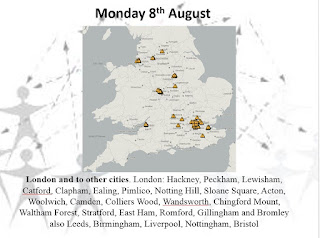I was asked today to appear on BBC Radio to comment on a report from the Association of British Commuters which described the recent experiences of passengers on Southern Rail trains and platforms. These testimonies painted a picture of stress, anxiety and fear for many passengers. The passengers’ concerns seemed understandable. People did not feel safe on the trains and platforms.
Based on the
research on the psychology of crowd safety, two factors that are important in
enhancing or diminishing the sense of safety that people feel in a crowd:
density and relationships of trust.
On density, we know
that density of five people per square metre (5ppm2) and above is objectively dangerous. Any push in a crowd of this density can cause a shock
wave and a fatal crush. And dense crowds have very poor front-to-back
communication, meaning that those at the back of a crowd have no idea how dense and dangerous it is at the front. So those at the back of a densely-packed
platform could accidentally push those at the front onto the rail without
realising.
Yet our research has
shown that, in many crowds of far greater density than 5ppm2, people
report feeling safe. This is what we found in our study of pilgrims’
experiences in the Grand Mosque, Mecca, during Hajj. So what is the other
factor that matters, that might be responsible for the feelings of anxiety and
fear among Southern Rail passengers?
The other factor is
a relationship of trust – specifically between the crowd and those managing the
crowd, as our research on other kinds of stressful crowd events has shown.
Commuters on trains rely on the company managing the trains and the stations.
They rely on them:
·
To manage the numbers. When this isn’t done it
undermines trust and confidence.
·
To have sufficient personnel available. This is
one of the problems highlighted by the Association of British Commuters (ABC) report.
·
To ensure the personnel are sufficiently trained.
One passenger comment in the ABC report is this: ‘on strike days, … more
concern for me is that there never seem to be any safety-qualified staff either
on the stations or on the trains’
·
To communicate reliably and regularly
If the company
cannot be relied upon to do these things, the result is quite understandable passenger
fear and anxiety.
Finally, the BBC asked
me about the dangerous behaviour by some passengers. Crowds of people made ‘mad
dashes’ across platforms to get to trains, sometimes risking their own and
others’ safety. And there were repeated reports of fighting.
Anxiety and fear alone
cannot account for these responses. When we looked at the behavioural responses of those commuters caught up in the London bombings of July 7th 2005, we found fear but we found almost none of these ‘antisocial’ responses.
In both cases (bombing and Southern Rail today) there was ‘scarcity’ – either of
safe passage or of trains running. But only in the case of Southern Rail today are
these passengers put in the position of being individuals competing against
other individuals. With a scarcity of trains, people defined as ‘customers’
compete, like people fighting over bargains in a sale. And with no reliable
information from the companies, it is not surprising that people treat the next
train as perhaps their last chance of getting home. Based on what we know about
how common fate changes the boundaries of concern for people faced with
disaster, perhaps the solution is collective identity and action as passengers
(not ‘customers’) to change the current situation for the common good.

